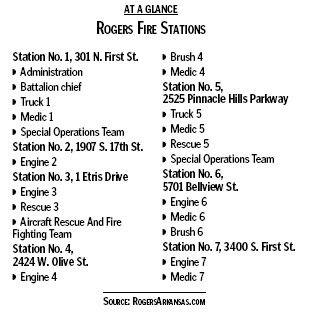ROGERS — Fire Chief Tom Jenkins is experimenting with reducing the number of active ambulances, a move he said could improve service and save money.
Jenkins is testing the idea at Station No. 3 at Rogers Municipal Airport and serves the northeast part of the city.
That station’s ambulance has been taken out of service for September. Medics at the station respond to calls on the fire truck, and an ambulance from another station provides transportation, if necessary.
“Trying to do everything out of every station doesn’t always work with a limited number of people,” Jenkins said.
If the test period is successful, Jenkins said he’ll apply the same model to Station 6 at 5701 Bellview Road.
The two stations together average less than one medical call per day, Jenkins said.
He said the change should improve response times because the medics won’t have to switch gear back and forth between a fire truck and an ambulance.
He said it also would save the city money because $200,000 ambulances won’t have to be replaced as often.
Medics perform tasks before they load the patient on an ambulance, such as starting intravenous drips. By the time fire truck medics have performed the initial tasks, the ambulance from another station should have arrived. Then the fire truck medics can go back in service, Jenkins said.
The station sending the ambulance will remain covered by a fire truck.
Capt. Rob Taylor works out of Station No. 3. He’s also chief of Northeast Benton County Fire and EMS.
He said, so far, he likes the new setup, especially because he and his crew don’t have to move gear between a fire truck and an ambulance.
“You’d always worry if you left something behind or was something misplaced,” he said. “It speeds up our response time because we’ve got everything in one place.”
Jenkins said the department could run out of ambulances in a mass casualty incident or if there are several smaller incidents at the same time. But, he said that’s always a possibility. The department has mutual-aid agreements with neighboring departments and could call in extra crews if necessary, he said.
Jenkins said he lives in the area covered by Station No. 2, which already operates without an ambulance.
Duane Atha, chief of the Springdale Fire Department, said his department has used a similar model for years, covering the city with ambulances at four of its six fire stations. He agreed it makes more sense to have crews at smaller stations run only fire trucks instead of trying to run ambulances and fire trucks.
“My feeling is we’re actually served better overall,” he said.
Atha said the department keeps three ambulances in reserve for mass casualty incidents.
Andy Rea, who lives near Station No. 3, said the plan sounded fine to him.
“I know I live close enough that I’ll get a really rapid response,” he said.

